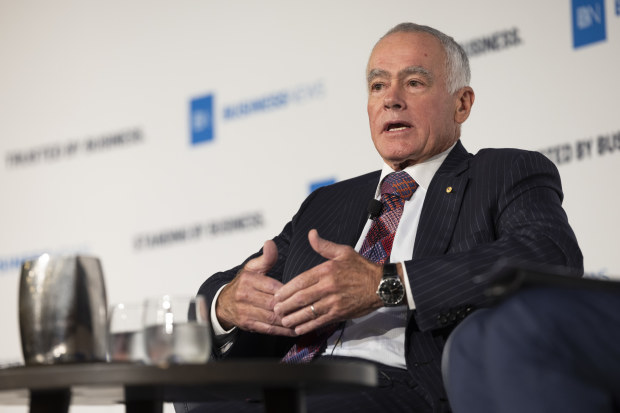Strike Energy pivots urea plant plans into new low-carbon precinct
Strike Energy has bought 3500 hectares of farming land in Western Australia to develop a renewables and manufacturing hub that the Perth-based company believes can produce some of the lowest-carbon urea fertiliser in the world.
Marking a change in strategy, Strike – whose board is led by prominent Perth business figures John Poynton and Nev Power – on Tuesday revealed plans to build its $3 billion, 1.4 million tonnes per year urea plant, known as “project Haber”, on newly acquired farm land in the state’s Mid-West, rather than the former site closer to Geraldton.

Strike Energy chairman John Poynton. Strike claims its urea fertiliser will be world-leading in terms of carbon emissions. Matt Jelonek
Strike said it would slice the project’s cost by $85 million by removing the need for a 105 kilometre gas pipeline to Geraldton, because the acquired freehold land sits above its South Erregulla gas fields and carbon sequestration reservoirs.
The $13.5 million land purchase will also save “hundreds of thousands of dollars in annual land access fees in the short term and millions over the life of the field” by having year-round access rather than post-harvest as is common with Perth Basin farms.
It’s still early days for the Haber project, which remains contingent upon the proving up of sufficient gas reserves at South Erregulla, and securing finance and potentially equity partners for the estimated $3 billion urea plant. Earlier this month the company said the Kingia gas discovery at South Erregulla had achieved one of the highest sustained flow rates in the Perth Basin’s history.
Strike claims its urea fertiliser could be world-leading in terms of carbon emissions, having around 0.38 tonnes of CO₂ per tonne of urea, about one-sixteenth the emissions intensity of the remaining domestic urea supply. It’s also described the project as a “national imperative”, given growing demand for urea, with Australia reliant on imports for 92 per cent of its consumption.
“Project Haber is also located on top of an excellent geosequestration reservoir, which can facilitate in time the emissions being brought to absolute zero (flue gas emissions abatement),” Strike said in a separate presentation to a Credit Suisse energy and ESG conference today.
“[This will produce] some of the lowest cost and lowest carbon fertiliser in the global market, which illustrates Strike’s commitment to net-zero by 2030,” Strike chief executive Stuart Nicholls added.
In late trade, Strike’s shares were up 0.8 per cent at 30.2¢.
The planned “Mid-West Low-Carbon Manufacturing Precinct” is slated to include more than 1500 hectares of carbon farming to generate carbon credits, and up to 170 megawatts of on-site renewable energy from wind and solar, with the company claiming it was the “ideal geographic setting”.
Strike doesn’t plan to own and operate the renewable energy assets or carbon farm, instead seeking to sign up to offtake arrangements for the power and potential carbon credits from the end developers, which have not been announced.
Surplus renewable power beyond Haber’s requirements could be made available for other industrial users which may “colocate” at the precinct, plus to power “additional green hydrogen production or fed into the state’s adjacent SWIS distribution and transmission network”, Strike added.
As for its gas assets, Strike’s goal is to be the nation’s “lowest cost onshore gas producer” amid forecasts from the Australian Energy Market Operator that gas supply and demand would remain finely balanced in WA in the next decade as the latter grows.
Ahead of Credit Suisse’s conference, the bank’s ESG analysts today told clients that only the “lowest cost, lowest carbon” gas production will compete in servicing “declining demand” after 2030 as renewables scale and dominate generation.
“Paradoxically, stronger carbon policies in Asia Pacific up to 2030 favour gas demand through locking in earlier coal-to-gas switching. However, beyond 2030-35, cheaper renewables and grid firming batteries see electrification winning out,” analyst Phineas Glover said.
Deputy WA Premier Roger Cook said the government “strongly” supported Strike’s plans, saying the low-carbon manufacturing precinct could generate substantial regional prosperity through job creation and import substitution.
Subscribe to gift this article
Gift 5 articles to anyone you choose each month when you subscribe.
Subscribe nowAlready a subscriber?
Introducing your Newsfeed
Follow the topics, people and companies that matter to you.
Find out moreRead More
Latest In Energy
Fetching latest articles